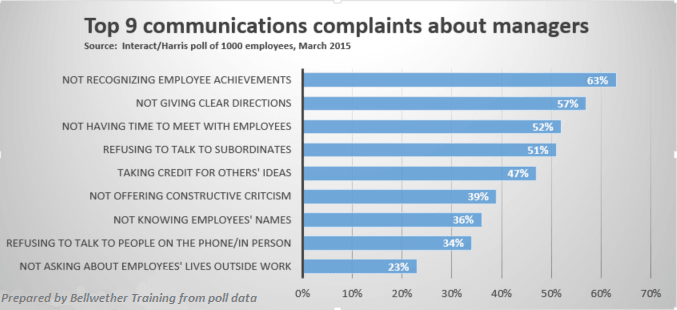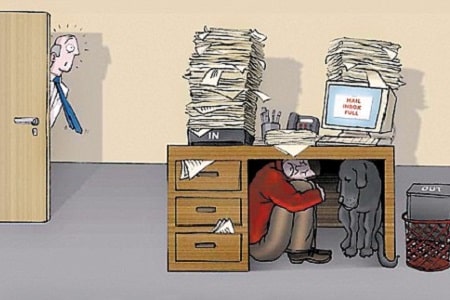Why Aren't They Doing What I Asked Them To Do?
As managers, sometimes it's difficult to understand why someone who works for us is not doing 100% of what we ask them to do... or 80%, or 60%... Is it laziness? They can't be bothered? They don't like us?
Then we happen to overhear that the same person spends unpaid hours volunteering for their church group, or coaching little league, and the non-performance puzzle becomes even more frustrating.
Mark Sanborn identifies 5 reasons people don't do what you ask them to at work. Here they are, listed from most common to least common:
1. They don't know what to do.
The most common reason people don't perform at work is that they don't know what they are supposed to be doing. We think people know what they are supposed to do but they are unclear. This is a COMMUNICATIONS issue. We can directly trace 60-80% of workplace performance issues to poor or ineffective communication.
A widely cited Interact/Harris poll reports the following top communications complaints by employees about their managers:

The number 2 complaint above by employees is that managers fail to give clear directions. 57% of employees said that this was a problem. You can't know WHAT to do if the directions are unclear.
What You Can Do
- Give people a clear understanding of what is expected. Define the Outcome (the "Afters") of what you are asking for. People can't hit a target they can't see. Employees need to know what they are trying to achieve as well as what they are trying to avoid. If you paint the bigger picture of how their output relates to the overall goal it will help them to understand what you are looking for from them.
- Clarify the what (outcome), the why, the how (best methodology), the how well, and the by when. We often fail to include the last two. If we don't clarify how well we want something done, it may lead to over-attentiveness and timewasting. By when is a deadline - let them know when you expect the results.
- Make sure that you define the priority that this task has in relation to others that they are working on. If necessary, conduct regular priority-setting reviews.
- Don't micromanage. According to Malcolm Higgs, director of the School of Management at Southampton University, "How tasks are structured has a big impact on employees' commitment and motivation. Motivated employees have some involvement in decisions that affect them, and are given a degree of autonomy and freedom to think about how to do things within a given framework."
- In general, make sure you communicate your expectations of them.
- Minimum expectations, i.e. the basic requirements of their job
- Desired expectations, based on what you think they are capable of. Set goals to give something to aspire to.
- Potential outcome - how good could they be? Allow people to pursue their potential, they know what's expected but they are able to aim higher. Goals alone inadvertently limit performance, as even the best of us tend to relax after we have achieved them. Overlay goal setting with a challenge: "Let's find out how good you can be"
2. They don't know how to do it
In their book “Developing Management Skills”, Whetten and Cameron propose the following equation:
Performance = Ability x Motivation, where
Ability is the team member’s aptitude as well as the training
and resources available.
Motivation is the result of desire and commitment.
Most often, lack of ability is a TRAINING and/or RESOURCE issue. However motivated your people are, lack of training or resources keeps them from being able to apply their motivation to the job in hand.
What You Can Do
Remove barriers. What keeps them from doing better work? Your job as a manager is to remove the impediments.
Resource barriers
- Make sure your team understands the resources available to them, and you have agreed the resources available are sufficient to the required task.
- Note any points of frustration.
- Note where they say support is inadequate.
- Verify with your own investigation. People will often blame external factors for non-performance before admitting they are to blame.
This is a very effective first step in addressing performance. It signals to people that you're interested in their point of view and are willing to make necessary changes.
Knowledge/Skills barriers
This exercise recognizes the value of constant skill development and the value you place on the employee. Provide additional training to team members where needed. Explore with them whether they have the actual skills required to do what's expected. Given the pace of change of technology, it's easy for people's skills to become outdated. Employees are motivated when they are challenged and see personal and professional growth.
Resource management and retraining will often cure poor performance. People get frustrated when they don't have the knowledge, resources and skills they need.
3. They don't know why they are supposed to be doing it.
This is a MOTIVATION issue. For people to want to do something, they need compelling reasons that make sense to them. Motivation is the difference between compliance and commitment.
Explain the "Motivational Why"
When communicating a task/a job function/a complex activity, explain the reason why. Sanborn calls this the "motivational why". People have a natural desire to ask why. Regrettably many managers see this as a form of insubordination rather than a natural curiosity. But often management has reasons that make sense to us but not to our people, and unless we take the time to thoroughly communicate why something is needed, how it fits in the big picture, people feel "managed" and resentment follows. Taking the time to explain why is a key step to a motivated team.
People don't only need the "business why", though that is important. They also need the "What's in it for me?"
The "motivational why" includes reward and recognition. Rewards are tangible, recognition intangible.
Provide Rewards and Recognition
Often we assume rewards to be monetary. But research suggests that the association between salary and job satisfaction is very weak. Malcolm Higgs points out: "Far too many companies work on the basis that money motivates. But money is not a motivator. If you give people more money you might get a quick lift in productivity but the effect of that dies off incredibly quickly. By and large, that is not what employees are there for."
In the Interact/Harris poll quoted above, the number 1 complaint by employees is that managers do not recognize their achievements.
People need to be noticed. Thank them and praise them - with specifics - when they have done a good job. Make people feel valued and trusted. Know what's important to them and reward them according to how they want to be rewarded.
Find out what makes them tick
To do that, we must take the time to find out what motivates them. We must personalize the motivation to the individual. Less than 15% of people have ever been asked what motivates them, which means that 85% of attempts to motivate people are based on assumptions and averages. Millennials especially are less likely to be motivated by a pay rise and more likely to value empowerment, recognition, flexible working arrangements, the ability to work within a team, and so on.
Create a motivational environment
Our job as managers is to motivate and increase morale, to create an environment where people find it easy to choose to be motivated.
Robert Levering, in his book "A Great Place to Work", asks the question: What do employees see as a great work environment? People always talk about three things:
- Trusting who they work for - Be trustworthy. People will trust you.
- Enjoying who they work with - Make it OK to have fun at work. People know they need to be serious about the results they produce but need the freedom to enjoy doing it.
- Being proud of what they do - People want to be part of a winning team. The greatest thing you can do for an employee is give them the freedom to make money and meaning.
Get motivated yourself!
Model the behavior you expect. Sometimes we expect our people to be more motivated than we are. As managers, everything we do promotes or pollutes. We are the thermostat, not the thermometer.
We need to bring the same energy and commitment to our work that we want our teams to bring.
4. They can't do it.
This is an ABILITY issue, by which I mean inherent ability, not training or resources. It's rare but serious. Your team member is trained, wants to do the work, is willing to make the effort, but doesn't have the skill-set.
What You Can Do
Are the task(s) that your employee is unable to do an integral part of their job? Can they be reallocated/outsourced and leave the employee with sufficient meaningful work to justify their continued presence in the position?
If you can reassign or outsource tasks it may be the best solution (explain what you are doing and why). If a task is central to the employee's role, then reassignment, demotion or termination are likely to be your only options. Often we shy away from making such decisions but the sooner you act, the better.
5. They won't do it.
Very occasionally, your knee-jerk reaction is correct. They really are lazy/can't be bothered/don't like you. Insubordination leading to non-performance is uncommon, serious, and grounds for dismissal. Read Mark Sanborn's blog (link below) for further input on this topic.
More Resources: Employees: Fix them or fire them? - Mark Sanborn
The Top Complaints from Employees About Their Leaders - Harvard Business Review
"Developing Management Skills" (8th Edition) - David A. Whetten & Kim S. Cameron
